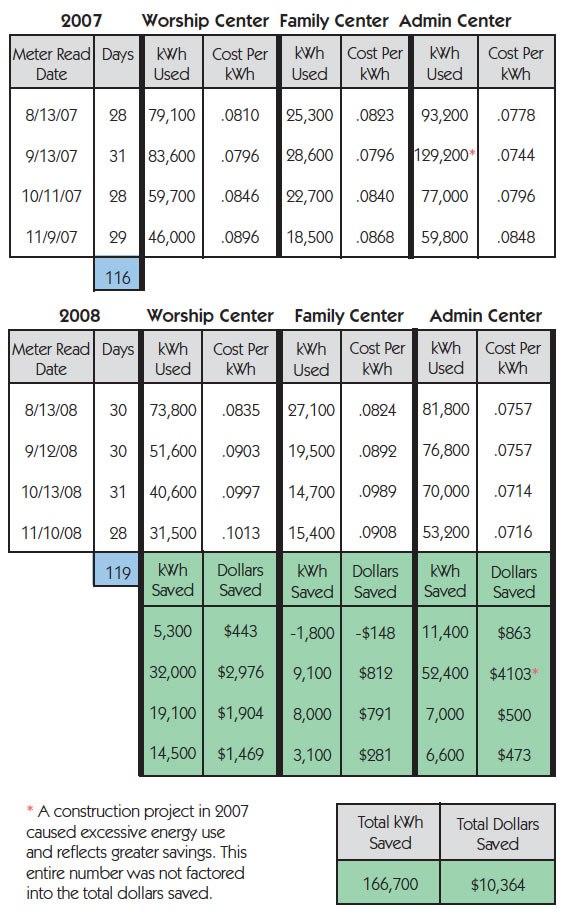The administrators of Colonial Baptist Church in Cary, NC had a problem common to most facilities with widely varying schedules and last minute events and changes. Energy costs were continuing to escalate, and trying to manage the HVAC equipment in multiple buildings had become an expensive nuisance and a frustration. They knew they had to find a way to permanently and affordably control their runaway HVAC energy costs. With a combination of standard and programmable thermostats (most with the ever-so-magical ‘hold’ feature), the problems were nearly daily in occurrence. Well-intentioned members of the congregation thought they were helping the facility engineer, Justin Barrett, by modifying schedules or adjusting the temperatures. Unfortunately, it was also common for them to press the ‘hold’ buttons, or forget to set back the thermostat(s) when their event was concluded. This resulted in unruly energy bills due to unneeded conditioning when the space was unoccupied. In some cases, it would be days before it was noticed the heat or cooling was still running!
As seen in Illustration 1, the church is comprised five (5) multipurpose buildings. Due to the nature of the buildings, this concern dealt with three (3) buildings. The Administration building is 25,500 sq. ft. and has eight (8) HVAC units and thermostats. The Family Center, also 25,500 sq. ft., has four (4) units. The most unique is the 34,500 sq. ft. Worship Center. It houses seven (7) thermostats and hosts 2000 attendees in each of two (2) Sunday morning services. During the summer months, cooling a congregation of that size is was a real challenge, but placing the Worship Center into an energy savings setback condition at the end of the second service was often overlooked. Conditioning 34,500 sq. ft. when it wasn’t needed was extraordinarily expensive.
Barrett had even tried expensive commercial setback thermostats, but that didn’t allow enough programs per day for the variety of activities at the multi-building campus. He searched for solutions and contacted Building Automation System (BAS) companies who quoted prices between $60,000 and $70,000. Being completely out of his budget, these costly estimates made him continue the search for something more affordable. “The building automation systems would certainly be effective, but they had too many features we just didn’t need”, said Barrett. The church wanted a simple to use system that would give them complete control and multiple schedules to program for each day. “Then, I saw an ad in a national church facilities magazine for a NetX™ networked thermostat system. I went to their website (www.networkthermostat.com), liked what I saw, and the price was right”, Barrett continued.
The company offers both wired and wireless choices. They could even be combined in the same system. For Colonial Baptist Church, Barrett initially selected the traditional ‘wired’ network thermostat system. Since a large portion of the buildings had drop-in ceiling tiles, pulling the communications cable wasn’t cumbersome, even though the buildings are almost 1000 feet long. The system was completed and running in late summer of 2008, making a dramatic reduction in the HVAC energy consumption. Colonial Baptist Church saved their 2007 electric utility bills and compared them to the same period after the networked thermostat system was installed in 2008, taking into account degree days and energy rates. “Over $10,300 is a lot to save for our church in just the first 4 months. Considering the system cost, we got an almost immediate payback and we’ll continue to save on energy costs for years to come.” Barrett remarked.
The savings for each building can be seen in the charts below. Notice that there were 3 more billing days in 2008; otherwise, the savings would have been even greater. Also note that the metered service charges per kWh were higher in 2008 in most cases. This made Colonial Baptist Church’s timely installation even more important.
Over the following six months, Colonial Baptist needed to move walls reconstruct areas to make better use of their ever changing needs. “At that point, we knew the wireless would be an amazing help. There would be no need to re-run the CAT5 communications cable when we needed to move the thermostats”, stated Barrett, so he added wireless backplates and wireless coordinators to his current system. He went on to say that installation was almost instantaneous. “We simply installed the new modules at the new thermostat locations and used the same network thermostat. To finish the installation, we connected the wireless coordinators to the existing network controllers. And to top it off, we had complete backward compatibility!”
The thermostat schedules were set through the NetX Command Center software, which can be loaded into any PC based computer. No additional computer hardware investment was required. They were able to easily set up to 6 different schedules per day and have drag and drop capabilities to copy schedules to any other thermostats on the network. Schedules are quickly modified with just a few keystrokes and mouse clicks at any time, allowing both comfort and savings to be maintained as the buildings’ activities varied.
One of Barrett’s favorite features is the lockout/override feature. By engaging the lockout, if someone decides they need to locally change the settings, they are limited to modify the settings by 3 degrees and for a maximum of either 1 or 3 hours. After that, the thermostat automatically returns to its scheduled setting. This feature has taken away the worry of wasted energy caused by well-intended people, according to Justin.
The powerful combination of networked thermostats, wireless communications, lockout/override features, point and click scheduling, real-time monitoring and stand-alone worry-free thermostat operation has made Justin Barrett and Colonial Baptist Church a believer in cost-effective HVAC control technologies. Network thermostats are the solution.




